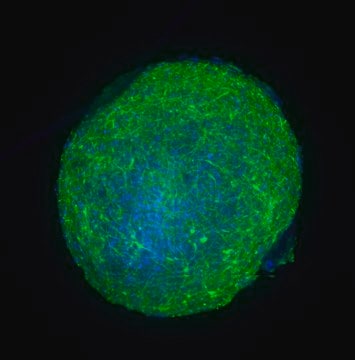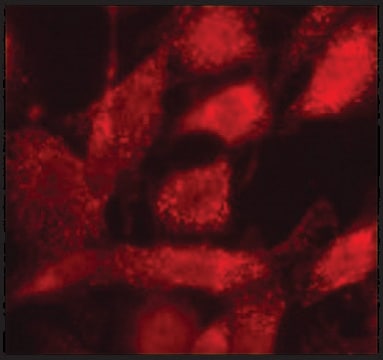PEROX1
Peroxisome Isolation Kit
isolate peroxisomes from tissues and cells
Synonym(s):
Isolation Kit for Peroxisomes, Kit for Peroxisomes, Peroxisome Kit
Sign Into View Organizational & Contract Pricing
All Photos(1)
About This Item
UNSPSC Code:
12352200
NACRES:
NA.32
Recommended Products
Quality Level
technique(s)
centrifugation: suitable
fractionation: suitable
shipped in
wet ice
storage temp.
2-8°C
General description
Isolated peroxisomes are used for studying lipid β-oxidation, amino acid metabolism and biosynthesis of ether-linked glycerolipids and bile acids.
Application
The Perixosome Isolation Kit provides all the necessary reagents and a detailed protocol for the isolation of highly purified peroxisomes from animal tissues and cells, by differential density gradient centrifugation using iodixanol [OptiPrep™]. This kit has been used for preparation of peroxisomes from rat liver, rat kidney and rabbit liver as well as HEK293 and HepG2 cells.
Features and Benefits
- Specially formulated extraction reagents for research scale applications - save time and minimize waste
- Produces functional intact organelles - resulting peroxisomes are suitable for functional studies, metabolic assays, protein profiling, and disease state analysis
- Compatible with products for structure confirmation - easily confirm intactness with companion test kit, Cytochrome C Reductase Assay Kit (Cat. No. CY0100)
Other Notes
Upon receiving the kit, the Protease Inhibitor Cocktail (Product Code P 8340) should be stored at –20 °C and the OptiPrep Density Gradient Medium (Product Code O3028) should be stored at room temperature.
Legal Information
OptiPrep is a trademark of Serumwerk Bernburg AG
Kit Components Also Available Separately
Product No.
Description
SDS
- P8340Protease Inhibitor Cocktail, for use with mammalian cell and tissue extracts, DMSO solutionSDS
Signal Word
Warning
Hazard Statements
Precautionary Statements
Hazard Classifications
Eye Irrit. 2 - Met. Corr. 1 - Skin Irrit. 2
Storage Class Code
8A - Combustible corrosive hazardous materials
Flash Point(F)
188.6 °F - closed cup
Flash Point(C)
87 °C - closed cup
Certificates of Analysis (COA)
Search for Certificates of Analysis (COA) by entering the products Lot/Batch Number. Lot and Batch Numbers can be found on a product’s label following the words ‘Lot’ or ‘Batch’.
Already Own This Product?
Find documentation for the products that you have recently purchased in the Document Library.
Customers Also Viewed
C M Rodrigues et al.
Journal of lipid research, 37(3), 540-550 (1996-03-01)
We recently demonstrated that the formation of delta 22-bile acids is a quantitatively major pathway for normal bile acid synthesis in the adult male Sprague-Dawley rat. This pathway is specific for 7 beta-hydroxy bile acids and, when ursodeoxycholic acid is
Shurong Hou et al.
SLAS discovery : advancing life sciences R & D, 22(7), 887-896 (2017-03-28)
Primary hyperoxaluria is the underlying cause of oxalosis and is a life-threatening autosomal recessive disease, for which treatment may require dialysis or dual liver-kidney transplantation. The most common primary hyperoxaluria type 1 (PH1) is caused by genetic mutations of a
M Une et al.
Journal of lipid research, 37(12), 2550-2556 (1996-12-01)
The oxidation of the side chains of two potential bile acid intermediates, 3 alpha,7 alpha,12 alpha-trihydroxy-5 beta-cholestanoic acid (THCA) and 3 alpha,7 alpha-dihydroxy-5 beta-cholestanoic acid (DHCA), were investigated in rat liver mitochondria and peroxisomes. Both THCA and DHCA were efficiently
M Y Kang et al.
Cell death and differentiation, 20(1), 117-129 (2012-08-25)
The tumor suppressor p53 is an important regulator of intracellular reactive oxygen species (ROS) levels, although downstream mediators of p53 remain to be elucidated. Here, we show that p53 and its downstream targets, p53-inducible ribonucleotide reductase (p53R2) and p53-inducible gene
Dieanira Erudaitius et al.
Free radical biology & medicine, 120, 356-367 (2018-03-31)
The high extracellular hydrogen peroxide (H2O2) concentrations generated during pharmacological ascorbate (P-AscH-) therapy has been shown to exhibit a high flux into susceptible cancer cells leading to a decrease in clonogenic survival. It is hypothesized that the intracellular H2O2 concentration
Our team of scientists has experience in all areas of research including Life Science, Material Science, Chemical Synthesis, Chromatography, Analytical and many others.
Contact Technical Service










